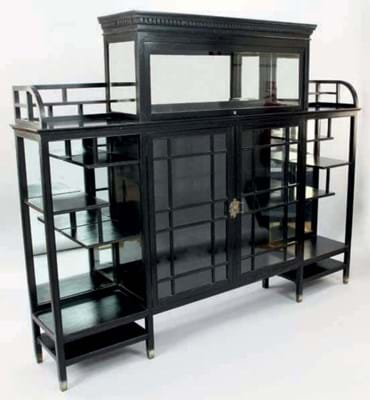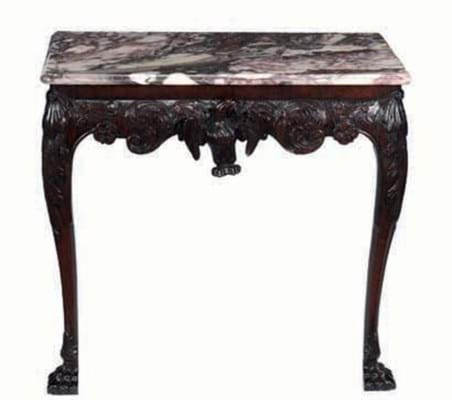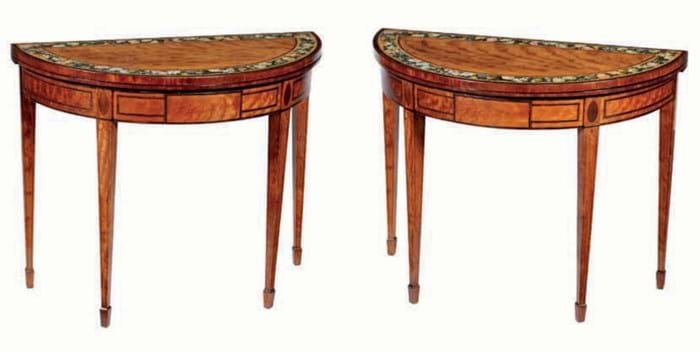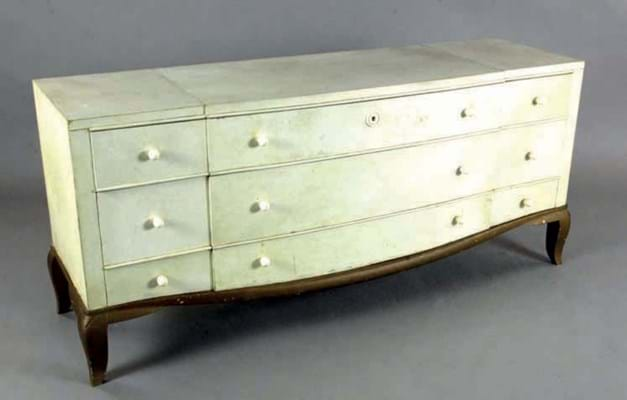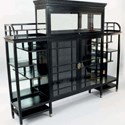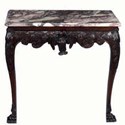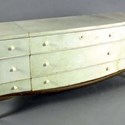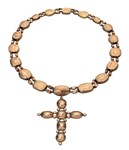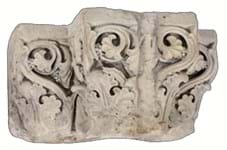Topping the March 21 sale at Gorringe’s (21% buyer’s premium) at Lewes and on thesaleroom.com, was a 1937-40 chiffonier by French designer, sculptor and architect André Arbus (1903-69). Entirely covered in parchment and on a gilt base, another example of the 5ft (1.52m) wide commode took a premium-inclusive €73,950 (then about £53,500) at Aguttes in Paris in June 2015.
The Gorringe’s piece, however, required some highly specialist restoration to both the ivory and the parchment, auctioneer Clifford Lansberry said. He was happy to see it sell to the Paris trade at £20,000 – double the mid-estimate.
“I found this as part of the routine valuation of a one-bedroom flat in Eastbourne,” Lansberry added. “The sale price comfortably exceeded the value of the remaining contents by 10 times or more.”
French connections
Elsewhere the furniture focus was on two pieces from the perennially under-rated Aesthetic movement. The Aesthetic star was the c.1872-75 ebonised mahogany display cabinet illustrated on these pages which was designed by Edward Godwin (1833-86), widely recognised as one of the major influences on late 19th and early 20th century furniture design.
Godwin is one of a few well-known names from the movement and his works, particularly those displaying the influence of 19th century Japan on Western arts, have commanded six-figure sums in the past.
A 6ft wide x 4ft 11in tall (1.83 x 1.50m) cabinet, with its ebonised finish in imitation of black lacquer, the use of stepped shelving and the brass sabots, was a good example of Godwin’s Anglo- Japanese designs.
As such, the £15,000-25,000 estimate seemed quite conservative, particularly as it was probably made by the highly regarded London firm Collinson & Lock and came with a good provenance.
“I found the Arbus chiffonier in valuing a one-bedroom flat in Eastbourne
However, after it sold to a London dealer at the lower estimate, Lansberry said: “I think the estimate was on the money – there are few buyers for this highbrow material.”
It was much the same tale in the case of a 3ft 3in wide x 5ft 5in high (99cm x 1.65m) oak chiffonier. It was designed by AW Blomfield – Sir Arthur William Blomfield (1829-89), vice-president of RIBA, designer of the Royal Courts of Justice in London – and featured stencilled fox, goose and flower decoration possibly by Clement Heaton (1824-82), a renowned maker of stained glass.
The piece was illustrated in Charles Locke Eastlake’s 1868 Hints on Household Taste The Classic Handbook of Victorian Interior Decoration.
Reprinted by Elibron Classics, the book is available today for about a tenner. Had it inspired an Aesthetic revival by modern decorators, no doubt the names of Blomfield and Heaton would be considerably better known, the chiffonier would have been estimated at more than £7000-10,000 and the (different) London dealer would have had to go higher than the lower figure to secure it.
About how traditional furniture is faring, Lansberry was brutally frank.
“It’s still terrible for everything except the true rarities,” he said. But, showing the optimism that seems to run through all auctioneers’ DNA, he added: “We have re-offered some of the unsold furniture in our weekly sale and achieved higher prices.”
He also had three rarities to boost sale figures of a 76% success rate on the 920 lots which totalled £762,000.
There was the occasional traditional piece of furniture which did well, such as a Regency mahogany dining table extending to 11ft 8in (3.55m) with two extra leaves which doubled expectations at £7200, selling to the Sussex trade.
Setting the bar high
At the triannual Furniture, Works of Art & Ceramics sale at Dreweatts & Bloomsbury (24% buyer’s premium) at Newbury on March 29, auctioneer Ben Brown had set the quality bar high and it showed in the results. Furniture entries dominated the day at the Donnington Priory rooms.
“It has been our policy for three years,” said Brown. “We recognised that as market growth was increasingly driven towards items of this quality, we could build successful sales in which we can sell furniture and decorative items very well.”
Of the 251 lots, 77% got away to a hammer total of £433,000. It was noticeable that the five-figure pieces generally went on lower estimates.
A c.1750 Irish mahogany console table led the day. With a breche violette marble top above an acanthus-carved shaped frieze centred by an eagle, the 3ft wide x 20in deep (90 x 50cm) table was a private buy at £15,000.
Two c.1750 Irish mahogany card tables, each with cabriole legs and lion-paw feet, were also private buys on the lower estimates.
One, with a 2ft 11in x 18in (88 x 45cm) rectangular top with rounded corners, featured a carved frieze with central medallion containing a bust flanked by foliate scrolls and eagles’ heads. It sold at £12,000.
The other, with a similarly sized top, was described as an excellent example of Irish craftsmanship.
It had the rare feature of acanthus carving running the length of the legs, unusual pierced elements to the frieze and carving to the terminals of the frieze to the reverse.
The baize inset was later and holed at the centre of the fold but otherwise there were only old minor fragmentary losses and marks consistent with age and the table sold at £8000.
A c.1750 mahogany and upholstered wing armchair, catalogued as ‘possibly Irish’, however, went at a five times estimate £10,000 to the UK trade – one of three dealer purchases in the sale’s top 10 price list.
Moore influence
Fine English 18th century furniture frequently went well above expectations, including another console table.
Dated c.1740, a walnut table had tapering cabriole legs headed by stylised shell terminals issuing bellflowers. The 4ft wide x 2ft deep (1.24m x 62cm) marble top was a replacement but it had some age along with its old minor chips and replacements.
It was incised IM to the front stretcher and the possibility that the table related to the maker John Moore may have influenced bidding. Against a £4000-6000 estimate, it went to a private buyer at £12,500.
Going more in line with expectations was a pair of c.1790 semi-elliptical satinwood card tables attributed to Gillows.
Each was painted with a band of floral decoration to the 3ft (92cm) wide tops which opened to reveal the baize playing surface. The friezes featured a central tablet and rosewood banded panels interspersed with inlaid ovals.
With some old chips and minor old replacements to small sections of veneer, the pair went to a private buyer at a mid-estimate £13,500.
This seems a decent price these days, although those still mourning the passing of the boom years may recall a related pair of tables – admittedly with an impeccable aristocratic provenance – took a premium-inclusive £58,000 at Christie’s back in July 2001.
Also with a pretty impressive provenance at Donnington Priory was a c.1710 double-dome bureau bookcase, formerly part of the furnishings of Luton Hoo, Bedfordshire, and coming to auction by direct family descent.
Standing 7ft tall and 3ft 6in wide (2.12 x 1.06m), the walnut and feather-banded bookcase featured bevelled glass inset doors above a fall with fitted well and two short and two long drawers.
There were some minor condition problems, but given a very modest estimate of £2000-3000, it went to the UK trade at £10,000.

